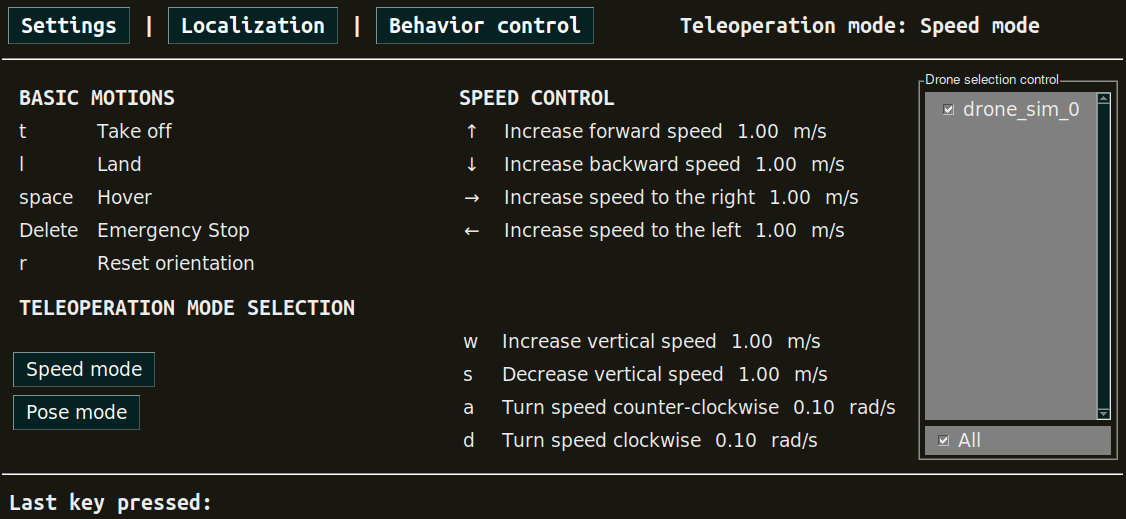Simple Tello Example
To install this project, clone the repository:
git clone https://github.com/aerostack2/project_dji_tello
To start using this project, please go to the root folder of the project.
Launching
The execution on the project is split into two parts: Aerostack2 components and ground station.
Launching Aerostack2
To launch the Aerostack2 components, execute the following command:
./launch_as2.bash
This will open a tmux session with an Aerostack2 instance for each drone launched.
Launcher offers a few options to customize the execution. ./launch_as2.bash -h will show option list. Options can be set with the following flags:
-n: select drones namespace to launch, values are comma separated. By default, it launches all drones from world description file.-g: launch using gnome-terminal. By default not set, uses tmux.
Launching Ground Station
To launch the ground station, execute the following command:
./launch_ground_station.bash
Launcher offers a different pool of options to customize the execution. ./launch_ground_station.bash -h will show option list. Options can be set with the following flags:
-m: disable launch mocap4ros2. By default set.-t: launch keyboard teleoperation. By default not set.-v: launch rviz. By default not set.-r: record rosbag. By default not set.-n: select drones namespace to launch, values are comma separated. By default, it launches all drones from world description file.-g: launch using gnome-terminal. By default not set, uses tmux.
Closing
Close all nodes (aerostack2 and ground_station) with the following command:
./stop_tmuxinator.bash
Note
The command tmux kill-server will have a similar effect but closing all tmux sessions, so be careful if you have other tmux sessions running.
If launcher was executed with the flag -g, closing should be done manually exiting all gnome-terminal tabs.
Close only the Aerostack2 nodes with the following command:
./stop_tmuxinator_as2.bash
Close only the ground station nodes with the following command:
./stop_tmuxinator_ground_station.bash
Mission execution
The project offers a few examples of mission execution.
Keyboard Teleoperation control: Using reactive teleoperation control. For both single and multiagent swarms.
Python API missions: Using Aerostack2 python API for mission definition. For single drone, using GPS and multiple drones.
Behavior Tree missions: Using Behavior Tree as the mission planner. For single drone only.
Mission Interpreter: Using Aerostack2 mission interpreter. For single drone only.
Keyboard Teleoperation control
In order to launch the components for a single drone, Aerostack2 launcher does not need any additional flags. Just execute ./launch_as2.bash.
Ground station should be launched with -t flag to enable keyboard teleoperation. Take a look at the keyboard teleoperation user guide for more information.
A window containing the teleoperation widget should pop up:

Keyboard teleoperation
Python API missions
In order to launch the components for multiple drones, both launchers require the flag -n indicating drone namespaces to use.
There are three python scripts available for mission execution in the project. For single drone missions, use python3 mission.py for flying a square.
For multi drone missions, use python3 mission_swarm.py where a group of drones will fly a swarm coreography. Here it is what the execution looks like:
Note
To understand how missions are built using the Aerostack2 python API, take a look at the Python API reference guide.
Mission Interpreter
Previous missions were defined using python syntaxis. Aerostask2 offers a mission interpreter that allows mission definition using a JSON format.
Currently, the mission interpreter script at the project is only available for single drone missions.
To launch the mission interpreter, execute python3 mission_interpreter.py.
The execution is similar to the python API mission where the drone will fly a square.
Behavior Tree
Missions can also be defined using a behavior tree. The project offers a mission example using a behavior tree for a single drone.
To launch the behavior tree mission, execute python3 mission_behavior_tree.py.
The execution is similar to the python API mission where the drone will fly a square.
Note
Trees can be defined using GUIs like Groot.